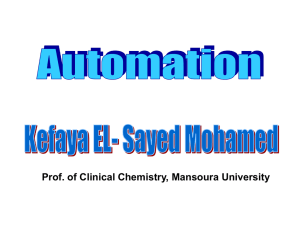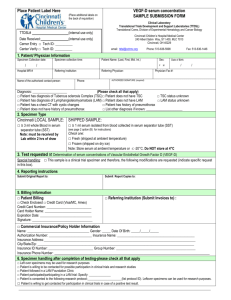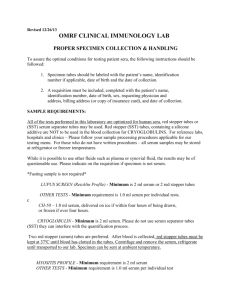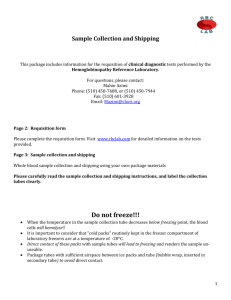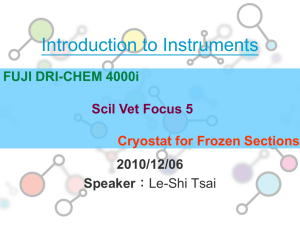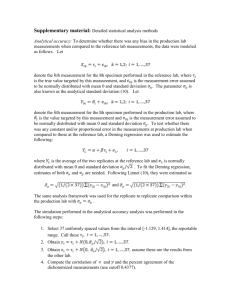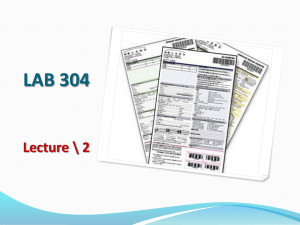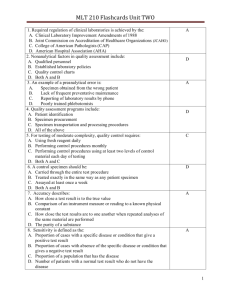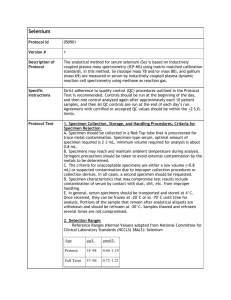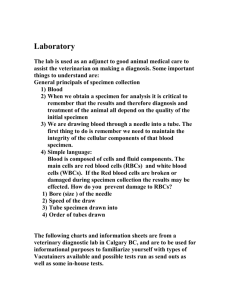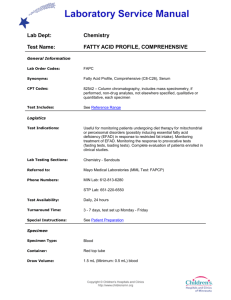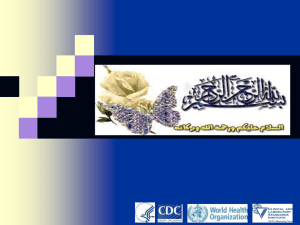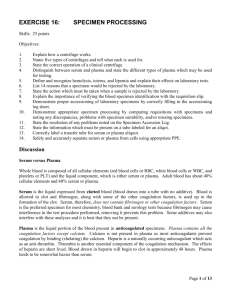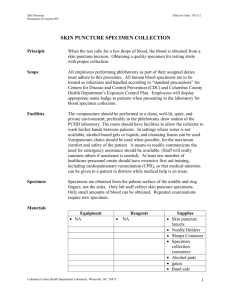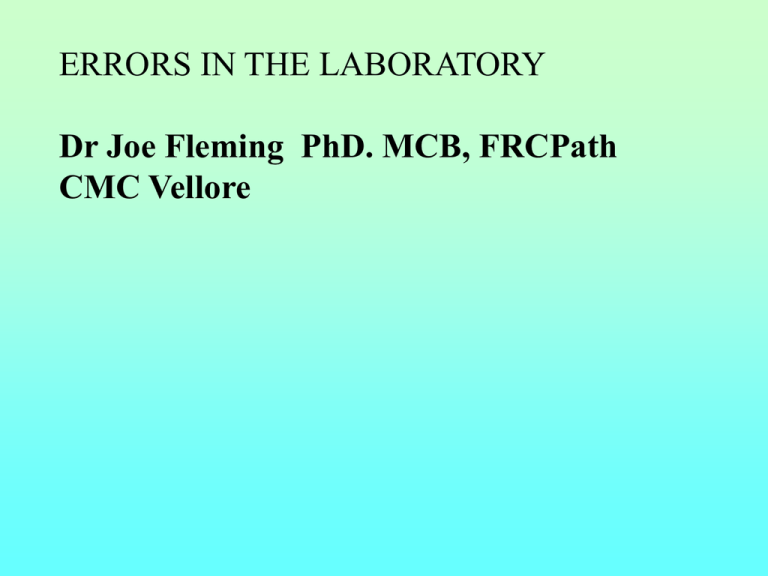
ERRORS IN THE LABORATORY
Dr Joe Fleming PhD. MCB, FRCPath
CMC Vellore
random errors inconsistent/unpredictable
Systematic errors consistent trend/shift in
values
could occur due to wrong procedure, incorrect
standard and calibration procedure.
Calibration error
Error can occur in any of the limb of the cycle of
events occurring in a hospital starting from the
physician examining the patient and back to the
physician
(preanalytical/ analytical/postanalytical).
Preanalytical
The pre-analytical system shall take care of the
following aspects as each can have a major effect
on the accuracy of the result :
Patient preparation
Request forms
• Specimen collection, containers, labeling
and phlebotomy equipment and procedure.
Specimen transport
Specimen preparation
Specimen storage
Pre-analytical errors:
Clinician must select appropriate investigations
Patient properly prepared for the test
Patient slip correctly filled in.
Note taken of the affect of age, sex, diet,
nutritional state, time on the particular test.
Patient was fasted or was not fasted overnight.
Effect of fist clenching
Contraction of forearm muscles causes release of
potassium
Intracellular electronegativity declines during
depolarization of muscle cells favoring release of
potassium rather than its uptake
Can cause 1-2 mmol/L increase
As much as 2.7 mmol/L increase reported -Lancet
1961;1:478-480
Patient variables
Patient and specimen identification
Dietary Status, Medications
Body Position (standing, sitting, supine)
Site of Phlebotomy vs site of infusion
Tourniquet (placement, duration)
Quality of Phlebotomy (trauma, duration, etc.)
Posture (sitting versus lying) can cause a 5%
variation in some tests. For total cholesterol and
HDL cholesterol it may be a 15% variation
Vigorous exercise can increase total cholesterol
by 6%
Smoking or stress
Wrong container used K EDTA for electrolytes,
ALP and calcium
Collection related factors
Filling of Tube (blood: additive ratio)
Order of Draw
Type of Tube (glass vs plastic)
Type of additive (none, anticoagulant, stabilizer,
separator)
Order of Specimen Collection
Blood culture tube
Coagulation tube (citrate)
Serum tube (with or without clot activator or gel
separator)
Heparin (with or without gel separator)
EDTA
Oxalate/ Fluoride
NCCLS (CLSI) H3-A5 standard, 2003
Transport related causes
Transport
- pneumatic tube
- courier
- shipment
Temperature & Humidity
Time
Specimen Integrity
Exposure to light
Process Related Causes
Time
Centrifuge
Temperature
Storage
Sample taken from drip arm while drip
running: If it is a dextrose saline drip it will
falsely increase glucose, decrease sodium,
chloride, urea and creatinine
Is the specimen volume adequate?
After centrifugation does the specimen show
haemolysis, icterus, lipaemia
Effect of tourniquet
Greater hemoconcentration: 3 min vs 1min
Venous stasis lead to increased anaerobic glycolysis,
accumulation of lactate, pH low
Hypoxic effect leads to leakage of K from cells: cause
spurious increase in serum K
Drop in blood pH result in release of ionic Ca & Mg
bound to albumin
Drop in blood pH: increase in free drug level
Exogenous Interference by Patients’ Medication
* Several drugs are known to interfere with
certain parameters.
* Laboratories should try to contact the
manufacturer for Drug interference or perform
studies to confirm the extent of interference from
drugs e.g Phenytoin affects measurements of
certain enzymes ALP & Gamma GT and
lowers serum levels of FSH, T4 etc.
Instructions for specimen collection should be given
to laboratory users in a primary sample collection
manual
Specimen collection, container, centrifuge speed
Time lapse in transport for blood gas analysis or
delay in analysis
Storage conditions . In some cases sample must be
frozen after separation in other cases it must not be
frozen. Freezing of whole blood will cause
haemolysis
Refrigerating
haemolysis.
whole
blood
may
also
cause
Substances in higher concentration inside the
red cells will leak into serum
Higher concentration in red cells than in
serum :
K, phosphate, AST, LDH
Lower
serum :
concentration in red cells than in
Na, Cl and carbon dioxide
Concentration about equal in red cells and
serum:
creatinine, glucose, urea, urate
Rejection after Processing and Analysis
* Serum indices are high – Bilirubin , Lipids, Hb
- These channels in the analyser will be
dedicated for these indices.
- Bilirubin is known to interfere with Creat,
Chol, Glucose, TG and Uric acid.
Analytical
The following aspects shall be monitored,
evaluated, implemented and maintained to ensure
accuracy and precision of the test carried out:
•
Quality of distilled water
•
calibration of measuring and testing
instruments including analysers, balances,
incubators, centrifuges and semi-automatic
pipettes,
and
regular
servicing
and
maintenance of equipment.
• use standard/calibrator which is traceable to
national/international reference material.
• include quality control specimens in each
procedure on a daily basis
Analytical errors
random
may be systematic or
All data relating to the laboratory’s internal QC
practices and performance in external quality
assessment schemes (scoring, ranks, etc.) should
be recorded, reviewed and corrective actions
implemented.
Stability of reagents
Laboratory personnel should be aware that
the stability of all reagents kept at room
temperature shall be reduced from the stated
values if the temperature exceeds 350C.
Use of calibration graphs
A fresh standard curve should be carried
out whenever:
the calibrator is changed
new reagents are introduced
problems with QC are encountered
Post-Analytical
In order to avoid transcriptional errors in
the results of the test, the reporting/signatory
technicians shall verify the results entered
manually or through on-line instrument
interfaces before the results are reported or
dispatched.
Post-analytical errors
Transcription errors
Excessive delay in reporting values
Correct interpretation
Rectification of lab errors
It is therefore essential to continually ask
the following questions.
1.
Is there an analytical error?
2.
If so, what type of error is this?
3.
4.
What could have been the causes for
this error?
How to rectify this error?

